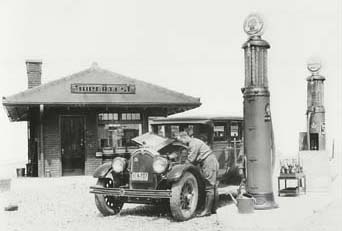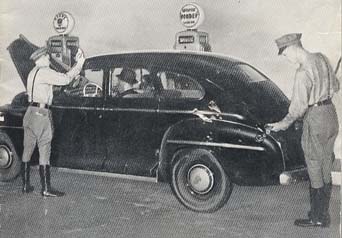

When J. Gordon Thompson and James D. Good opened London's first modern
service station back in 1923 , few people realized that a whole new concept of gas-
oline merchandising was being pioneered by the two young men cleaning the
customer's windshield and checking under the hood.
Yet it was this unheard of courtesy to motorists that put the word "service"
into Canada's service stations.

resembling the modern service stations of today (1959) certainly did not exist in
Canada. Gasoline, oil and lubrication for the ever-increasing army of automobiles and
trucks was becoming a lucrative trade, but no one seemed to pay much attention to it.
Gasoline was dispensed from 'blind' hand operated pumps. You couldn't see if you
were getting gas or not and sometimes the measurement was not too accurate. The
pumps were usually located on the curb outside hardware stores or garages. There were
no spacious driveways or pump islands.
After pulling up at one of these pumps , a motorist was obliged to get out of his car,
walk into the store and ask for what he wanted -- often there was no one there to help
and he had to wait. Sometimes he was even told to help himself ! Many of the early
Canadian distributors of petroleum products were inclined to consider the sale of
gasoline a nuisance.
When the motorist of that day had his tank filled with gasoline and his motor topped
up with oil , he didn't expect anything else. The free services taken for granted today
(1959) just didn't exist. When the car driver thought his high pressure tires might be low,
he checked them himself with his own tire gauge which he was obliged to carry. If the
tires did require air, he usually hauled out his own pump and went to work. Occasionally
he was lucky enough to find a free air hose at a garage , but he still had to get out of his
car and use it himself.
You wiped your own windshield too , and checked your own oil . Restrooms ? They
were certainly out of the question - when you did find one , it could hardly be called a
"restroom".
The idea for a service station catering especially to the needs of the motoring public,
arose originally in the minds of two young men of London , Ontario; J. Gordon
Thompson and James D. Good, the founders and first employees of London
Automotive Services. They named the gasoline they sold "Supertest".
These young men had the vision to foresee a continuous expansion of the oil industry
in Canada. They had the courage, too, to put their "radical" ideas into operation.
J. Gordon Thompson is quoted as saying the Supertest name came to him one
evening at a London moving picture show. " In those days" he recalled "they used to
call the show of the evening the 'Super Feature'. A competitor of mine was advertising
what he called 'Hi-Test'. The word Super was a natural, and we incorporated as the
Supertest Company".

Armed chiefly with confidence in their own ideas and abundant energy, the two
succeeded in interesting a few friends who were able to back them financially. They
then set to work to put their theories to the test by buying out a small jobber whose
business was on the rocks. Included in the deal was a disreputable looking gasoline
"filling" station , a small bulk plant and a couple of worn out tank trucks.
They started with a "filling" station, and before very long the nations first "service"
station began to take shape. It was indeed something new - it actually allowed motorists
to drive in off the highway and pull up to a thing called a pump island , soon to be
upgraded with visible gasoline pumps, manufactured by another of J. Gordon
Thompson's enterprises, Canada Vulcanizer & Equipment Company (1920), also
of London. But there was more to come ...

While renovations
were still under way , the first small staff for the station was
recruited . The
scheme called for at least two full-time attendants on duty always; one
would take care of
the gasoline and oil sales , the other would look after the free
services such as cleaning
the windshield, mirrors and lamps,
checking the tires , the
radiator and the battery.
The first crew was started
at once on an intensive training course which included daily
lectures on personal cleanliness,
smartness of appearance, neatness of the premises ,
courtesy to customers and applied
sales psychology. The first course was so successful
that Supertest still (1959) uses
much of the original instructional material in schooling
new station personnel, and for
the dealers.
(The
March 2003 Monthly Feature will detail the Supertest Courtesy School --
stay tuned !)
Meanwhile, scrubbing,
painting, whitewashing and alterations had changed the
once shabby
station to an attractive establishment gleaming with colour and bright
lights. When
all was ready, the station was reopened -- and then the fun started .
Nothing like it had
been seen in London before . Soon all kinds of people were
driving from
near and far to satisfy their curiosity about this amazing new place
where one could drive
in off the highway, pull up to the state of the art visible
measure pumps in perfect
safety and get the tank filled with
gasoline, the oil and
radiator checked , the windshield
and lamps cleaned and even the tires
checked,
and all free of charge except for
the product needed, which
cost no more.
Even tips were not allowed.

conquered for they came back, again and again. Even the most skeptical among
competing companies had to admit the Supertest experiment was a resounding success.
Before long competitors copied the idea and these practices are now standard. It has
become a way of living, and motorists now demand these services or they go
elsewhere. The campaign eventually went so far as to offer the gasoline free if the
attendant failed to wipe your windows or check the oil.
Thus, the opening of Supertest's first service station in London , Ontario, can be said
to have ushered in a new era in the marketing of gasoline and petroleum products, not
only in Canada , but elsewhere throughout the world. Within five years (1928), the
Supertest Petroleum Corporation Limited had expanded to 75 retail outlets.

through some 3,000 retail outlets in Ontario and Quebec, of which, over 1300, are
company owned. These retail outlets are supplied by some 50 strategically located bulk
storage plants.
Supertest operates a fleet of 300 tank trucks and maintains divisional offices in
Windsor, London, Hamilton, Toronto, Ottawa, North Bay, Montreal, and Quebec City.
reorganization involving Supertest and multi-national British Petroleum Corporation
(B.P.), with Supertest becoming part of a new entity called BP Canada Ltd. The firm
became the fifth largest oil company in Canada, after Imperial Esso, Shell, Gulf and
Texaco , accounting for slightly more than a 14% market share . Unfortunately this
merger would bring about the demise of the "All Canadian" slogan , so long a part of
Supertest advertising . During a brief transition period they became known as
BP Supertest before slowly phasing out the Supertest name.
One of the most valuable assets BP obtained in the merger was the Supertest reputation.
 ........
........
The poster on the left is very reminiscent of the 1927 photos shown at the beginning of
this feature. So much so that I feel they may well have been the inspiration for the
poster.
The pump is clearly a Canada Vulcanizer, a flashback to Supertest's beginnings. Even
the automobile at the pump bears a striking resemblance, right down to the wooden
spoke wheels.
On the right, my friend, Harry Littleton mimics the pose. Harry began his career with
Canadian Oil Co. Ltd. (White Rose). Eventually Harry moved over to the Supertest
family . Following the merger with BP in 1971 , Harry found he had a new employer.
Not eager to move from London to the new Toronto Head Office , he considered
retirement , but was offered the opportunity to promote BP's latest acquisition and
advertising campaign.
Dressed in brand new, old style uniforms, complete with breeches, leather leggings
(putties), Sam Brown shoulder strap, a leather bow tie and a new old style attendants
cap, all adorned with the BP shield, Harry made the circuit, visiting stations, exhibitions
and country fairs. All to promote BP's newest campaign "Service is Back" , an idea
that originated right in our backyards.
Both companies were strong in the Ontario-Quebec market with about 3000 stations
between them. Supertest, befitting its London base, was strongest in western and south-
western Ontario, while BP ,of Montreal, was strongest in Quebec and Eastern Ontario.
Like a jigsaw puzzle the two fitted together --- with their strengths complementing one
another.
BP Canada wanted the changeover from Supertest to BP signs completed by Dec. 31,
1974. At the very least the words "All Canadian" were not to appear on any company
signs. It was decided it would be cost prohibitive to replace all the Supertest signs right
away, but all new Supertest signs would not have the motto. I have been told that the
slogan was simply covered or painted over as the deadline drew closer. With respect
for Supertest's roots, the changeover was done last in Southwestern Ontario.
Rebranding of former Supertest stations in Quebec and Eastern Ontario was completed
almost a year before.
Because of the merger, a duplication of service resulted with Supertest and BP
stations often being close to one another. This occurred in more than 900 (company
owned) locations.
Thus the older, smaller, less profitable stations with low gasoline volumes were cut in
favor of bigger, newer, high volume stations.